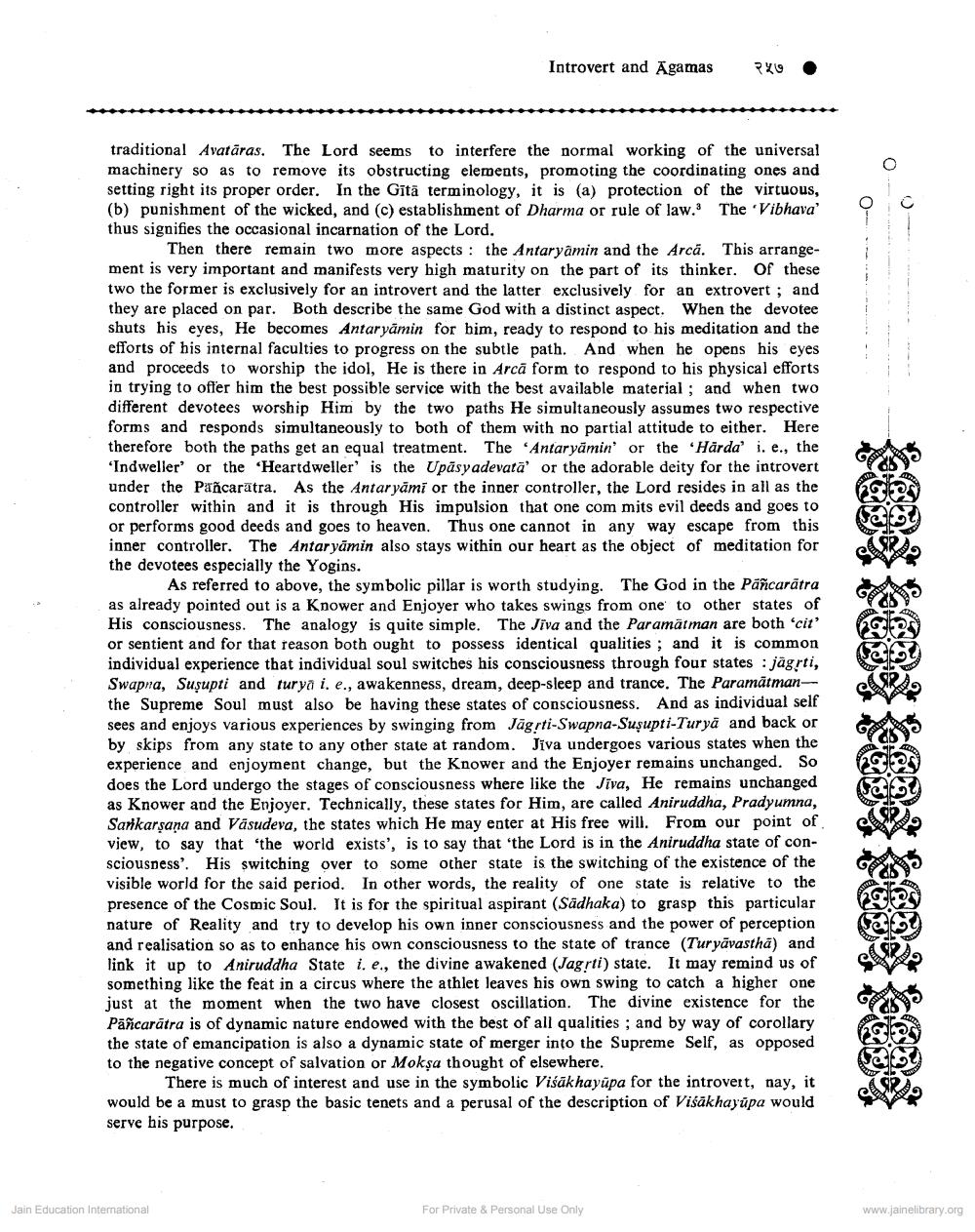Book Title: Introvert and Agamas Author(s): Prabhakar Apte Publisher: Z_Pushkarmuni_Abhinandan_Granth_012012.pdf View full book textPage 3
________________ Introvert and Agamas 257 traditional Avataras. The Lord seems to interfere the normal working of the universal machinery so as to remove its obstructing elements, promoting the coordinating ones and setting right its proper order. In the Gita terminology, it is (a) protection of the virtuous, (b) punishment of the wicked, and (c) establishment of Dharma or rule of law. The Vibhava' thus signifies the occasional incarnation of the Lord. Then there remain two more aspects : the Antaryamin and the Arca. This arrangement is very important and manifests very high maturity on the part of its thinker. Of these two the former is exclusively for an introvert and the latter exclusively for an extrovert ; and they are placed on par. Both describe the same God with a distinct aspect. When the devotee shuts his eyes, He becomes Antaryamin for him, ready to respond to his meditation and the efforts of his internal faculties to progress on the subtle path. And when he opens his eyes and proceeds to worship the idol, He is there in Arca form to respond to his physical efforts in trying to offer him the best possible service with the best available material, and when two different devotees worship Him by the two paths He simultaneously assumes two respective forms and responds simultaneously to both of them with no partial attitude to either. Here therefore both the paths get an equal treatment. The Antaryamin' or the 'Harda' i. e., the 'Indweller' or the Heartdweller' is the Upasyadevata' or the adorable deity for the introvert under the Pancaratra. As the Antar yami or the inner controller, the Lord resides in all as the controller within and it is through His impulsion that one com mits evil deeds and goes to or performs good deeds and goes to heaven. Thus one cannot in any way escape from this inner controller. The Antaryamin also stays within our heart as the object of meditation for the devotees especially the Yogins. As referred to above, the symbolic pillar is worth studying. The God in the Pancaratra as already pointed out is a Knower and Enjoyer who takes swings from one to other states of His consciousness. The analogy is quite simple. The Jiva and the Paramatman are both 'cit' or sentient and for that reason both ought to possess identical qualities; and it is common individual experience that individual soul switches his consciousness through four states : jagrti, Swapna, Susupti and turya i, e., awakenness, dream, deep-sleep and trance. The Paramatmanthe Supreme Soul must also be having these states of consciousness. And as individual self sees and enjoys various experiences by swinging from Jagrti-Swapna-Susupti-Turya and back or by skips from any state to any other state at random. Jiva undergoes various states when the experience and enjoyment change, but the Knower and the Enjoyer remains unchanged. So does the Lord undergo the stages of consciousness where like the Jiva, He remains unchanged as Knower and the Enjoyer. Technically, these states for Him, are called Aniruddha, Pradyumna, Sarkarsana and Vasudeva, the states which He may enter at His free will. From our point of view, to say that the world exists', is to say that 'the Lord is in the Aniruddha state of consciousness'. His switching over to some other state is the switching of the existence of the visible world for the said period. In other words, the reality of one state is relative to the presence of the Cosmic Soul. It is for the spiritual aspirant (Sadhaka) to grasp this particular nature of Reality and try to develop his own inner consciousness and the power of perception and realisation so as to enhance his own consciousness to the state of trance (Turyavastha) and link it up to Aniruddha State i. e., the divine awakened (Jagrti) state. It may remind us of something like the feat in a circus where the athlet leaves his own swing to catch a higher one just at the moment when the two have closest oscillation. The divine existence for the Pancaratra is of dynamic nature endowed with the best of all qualities ; and by way of corollary the state of emancipation is also a dynamic state of merger into the Supreme Self, as opposed to the negative concept of salvation or Moksa thought of elsewhere. There is much of interest and use in the symbolic Visak hayupa for the introvert, nay, it would be a must to grasp the basic tenets and a perusal of the description of Visakhayupa would serve his purpose. Jain Education International For Private & Personal Use Only www.jainelibrary.orgPage Navigation
1 2 3
